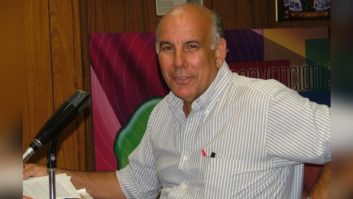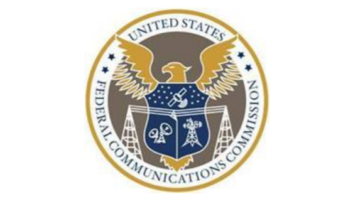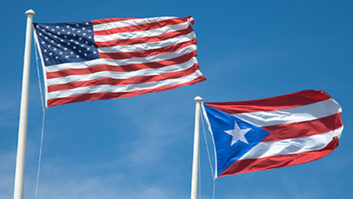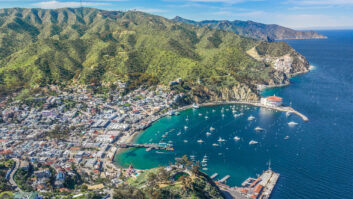Many weeks after Hurricane Maria devastated Puerto Rico’s infrastructure, radio broadcasters there were struggling to get and keep their signals in air.
Most of the AM/FM stations in service were relying on diesel generators for electricity, because the island’s storm-ravaged power grid was still in terrible shape.

Damaged WIPR infrastructure.
Other stations were just too damaged to get back on air without substantial reconstruction, and that’s a problem since money is in short supply in Puerto Rico these days. Due to the devastation, “there’s no business for radio stations, and when there’s no business there’s no money,” said Jose Ribas Dominicci, executive director of the Puerto Rico Radio Broadcasters Association.
In response to this situation — which has not only affected radio station owners and their staff, but also the people of Puerto Rico who rely on radio for information — U.S. broadcasters are providing money, equipment and support to their broadcast brethren in the territory.
“Our members understand what it is like to be slammed by a hurricane, and remember how other broadcasters helped them out in times like these,” said Vance Harrison, president of the National Alliance of State Broadcasters Associations. “We’re stepping up to help our fellow radio stations in Puerto Rico, just as they would if we were in such serious trouble.”
THE BIGGEST NEED

In San Juan, Jose Otero of Puerto Rico Public Broadcasting Corp., left, works with Peter Polanco and Dannie Raghunath of WNYC to raise a temporary antenna.
What do Puerto Rico’s radio broadcasters need most? The answer is simple.
“With so many stations relying on diesel and gasoline generators to stay on air, money is needed to pay for the fuel, at a time when advertising is not coming in,” Ribas said. “Without that fuel, which has to be purchased constantly, we can’t keep broadcasting.”
To help pay these fuel costs, the Puerto Rico Radio Broadcasters Association opened a bank account to accept donations on behalf of radio broadcasters there and in the U.S. Virgin Islands, both pummelled by Maria. The PRRBA hopes to raise $250,000 to help these broadcasters get back in service and stay on air.
“Getting Puerto Rican radio back on its feet is going to be a long-term challenge, due to the fundamental damage they’ve suffered there,” said VAB Executive Director Jim Condon. “So we need to be there for our fellow broadcasters, for the long haul.”
In early November, donations had come in from NASBA plus individual groups such as the Florida Association of Broadcasters and the Vermont Association of Broadcasters, and the fund had raised $25,000, said Harrison. “But much more is definitely needed.”
Ribas subsequently emailed that the Maine Association of Broadcasters had contributed another $25,000.
WNYC’S HANDS-ON APPROACH

NAB Building Engineer Louis Abanez, NAB’s Suzie Raven and Mayor Lornna Soto address a crowd in Canóvanas in northeastern Puerto Rico.
New York City public stations WNYC(AM/FM) understands the experience of having broadcast infrastructure devastated.
“Our FM transmitter was located on the World Trade Center, which came down on 9/11,” said Steve Shultis, its chief technology officer. “Had we not received help from WKCR(FM), who lent us a studio, and WNYE(FM), who found us a frequency and transmitter, we would have been knocked off air for a long time. So we know what it is like to need help, and to receive it.”
When WNYC’s staff learned that San Juan public station WIPR had lost its mountaintop transmission/antenna facilities — “When we visited the site, we saw wreckage everywhere,” said WNYC Engineering Manager Dannie Raghunath — they wanted to help. That’s where the nonprofit CoastAlaska media collective came in. As Shultis recounted it, “They contacted WNYC to tell us that CoastAlaska had built two ‘radio-to-go’ kits, each of which would let them set up a temporary station after a tsunami. So we asked CoastAlaska to lend us a kit to take to Puerto Rico, and they did.”

Suzie Raven of NAB, NAB Building Engineer Louis Abanez, Jose Ribas of Puerto Rico Association of Broadcasters and FEMA contractor Josivan Rojas.
Equipped with the 300-pound radio-to-go kit — filled with microphones and mixer to a 150-watt transmitter and 30-foot standalone vertical antenna mast — Raghunath and fellow WNYC engineer Peter Polanco travelled to Puerto Rico in October to get WIPR back on air. “We had an armed guard escort us and our equipment from the airport to the hotel,” Raghunath said. “That’s just how the situation there is right now.”
In three days’ time, the two WNYC engineers had set up the kit at WIPR’s San Juan studios, and erected the antenna mast on its roof, held in place by cinder blocks on its tripod legs.
“We are getting a 3 dB gain on the antenna, which is carrying 150 watts on FM throughout Greater San Juan in a 20-mile radius,” said Shultis. “It certainly is no match for WIPR’s original 150,000 watt signal from its mountaintop antenna, but this temporary setup is still a big help.”
RADIOS TO THE RESCUE

Uprooted tree in Loiza.
Maria didn’t just knock out radio coverage in Puerto Rico, it also destroyed the radios that people used to tune into this coverage. (The same is true for TV, cellular telephone and internet service; all of which were still severely compromised due to physical damage and lack of power.)
The National Association of Broadcasters, NASBA and many unnamed U.S. broadcasters banded together to send 10,000 portable radios to the people of Puerto Rico.
“Time and again, broadcast radio has served as a lifeline to communities desperate for information and support,” stated NAB President and CEO Gordon Smith in an NAB news release. “Our fellow Americans in the Caribbean now face a once-in-a-generation humanitarian crisis, and radio is one of the only communications resources available.”

Young boy receives a radio in Rio Grande, near El Yunque National Forest.
The 10,000 radios were cassette tape-sized QFX R-9s. Capable of AM, FM and SW (shortwave) signals, each R-9 comes with a telescopic antenna, LED power indicator and a 3.5 mm earphone jack. They retail online for $9.99.
The NAB/NASBA/broadcasters coalition that acquired 10,000 of these for Puerto Rico also supplied two pairs of AA batteries with each radio. “We found the R-9s on the West Coast, and had them shipped to Florida,” said FAB President Pat Roberts. “Even at their small size, the 10,000 R-9 radios required three pallets to ship them. The 40,000 AA batteries needed six pallets more.”
After much legwork, the radios/batteries were flown into Puerto Rico and the U.S. Virgin islands in October.
Suzanne Raven, NAB’s senior manager of public service, was on the ground in Puerto Rico with NAB Building Engineer Louis Abanez when the radios were distributed with FEMA’s help to 25 communities there.

A man listens to one of the donated radios in the small coastal town of Loiza.
“It was touching to see the faces of Puerto Rican children light up when we handed them a new radio. People literally danced in the streets,” said Raven. “Residents flocked to us, particularly after dark when our vehicles provided the only lights for miles.
“Word of mouth was key in making the mayors’ offices aware of our initiative,” she said. “Some mayors only became aware of our radio distribution upon arriving in San Juan. Without cell service, they could not receive messages about our efforts.”
This generosity played out against a backdrop of fearsome destruction. “Most of Puerto Rico remained without power and drinkable water during our visit,” said Raven. “Even in the capitol of San Juan, power came almost exclusively from generators that had to be refilled with fuel or diesel daily by hand, sometimes every four hours.
“Seeing the devastation drove home the need for reliable communication,” Raven said. “Cellphone connections and Internet service are non-existent in many parts of Puerto Rico. Broadcast radio continues to connect people to critical information.”
THE NEED IS REAL

The QFX R-9 is a small multi-band receiver.
It will take months, or even years, for the industry and its island home to recover from Maria’s bulldozer-like destruction.
“As Floridians, we know what it is like to be where Puerto Rico finds itself today,” said FAB’s Pat Roberts. “This is why our broadcasters are doing all they can to help our radio colleagues there, and we urge all other broadcasters to join us in doing so.”
To donate money to the PRRBA’s fund for broadcasters in Puerto Rico and the Virgin Islands:
Financial Institution: Banco Popular de Puerto Rico
Account Holder: Asociación de Radiodifusores de P.R.
Account Number: 203544423
Routing Number: 021502011
Swift Code: vpprprsx











